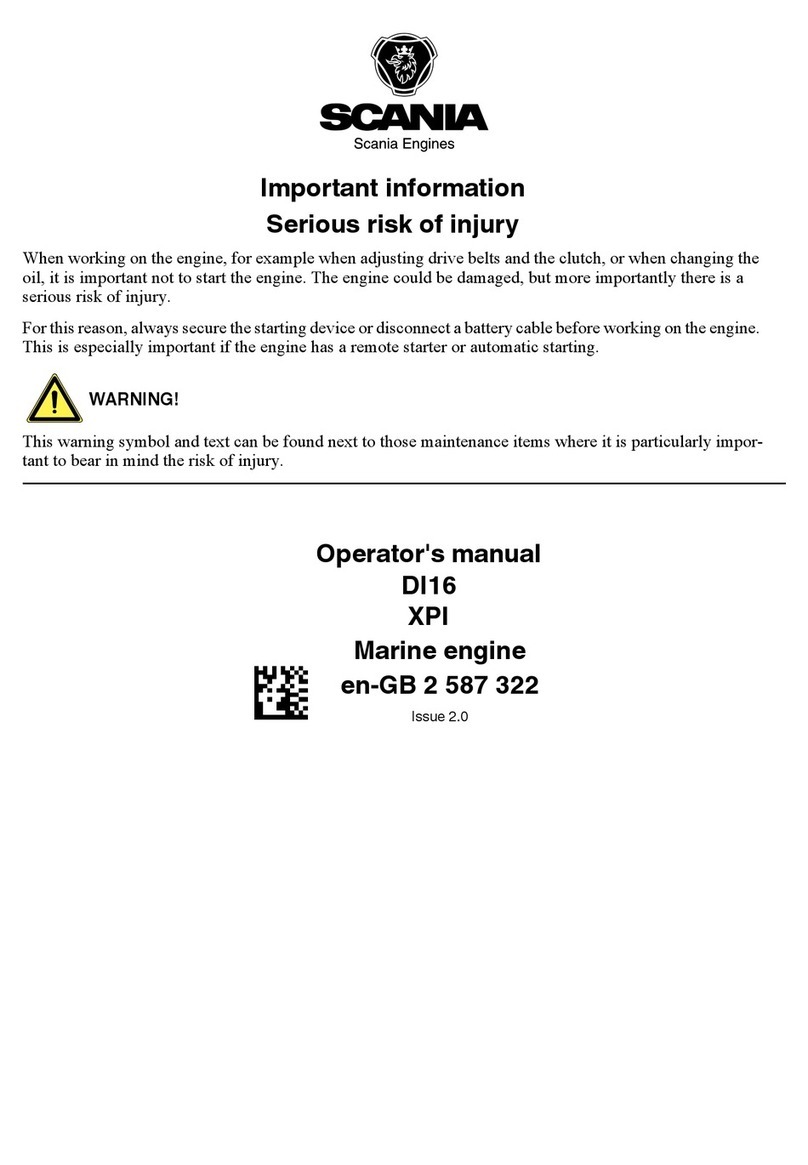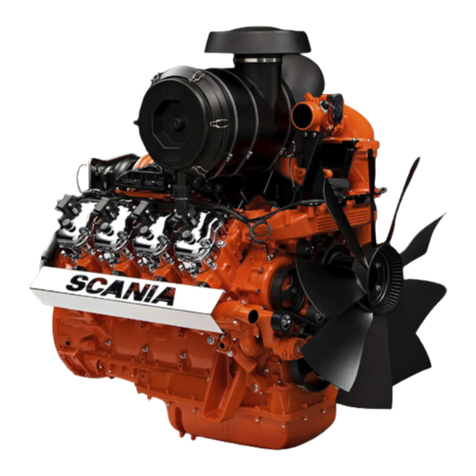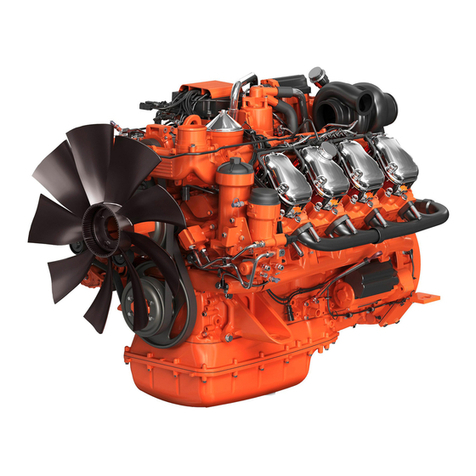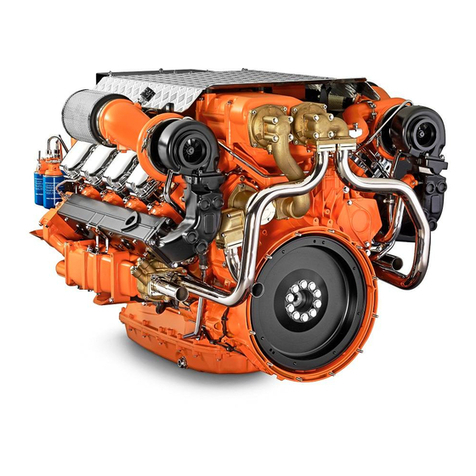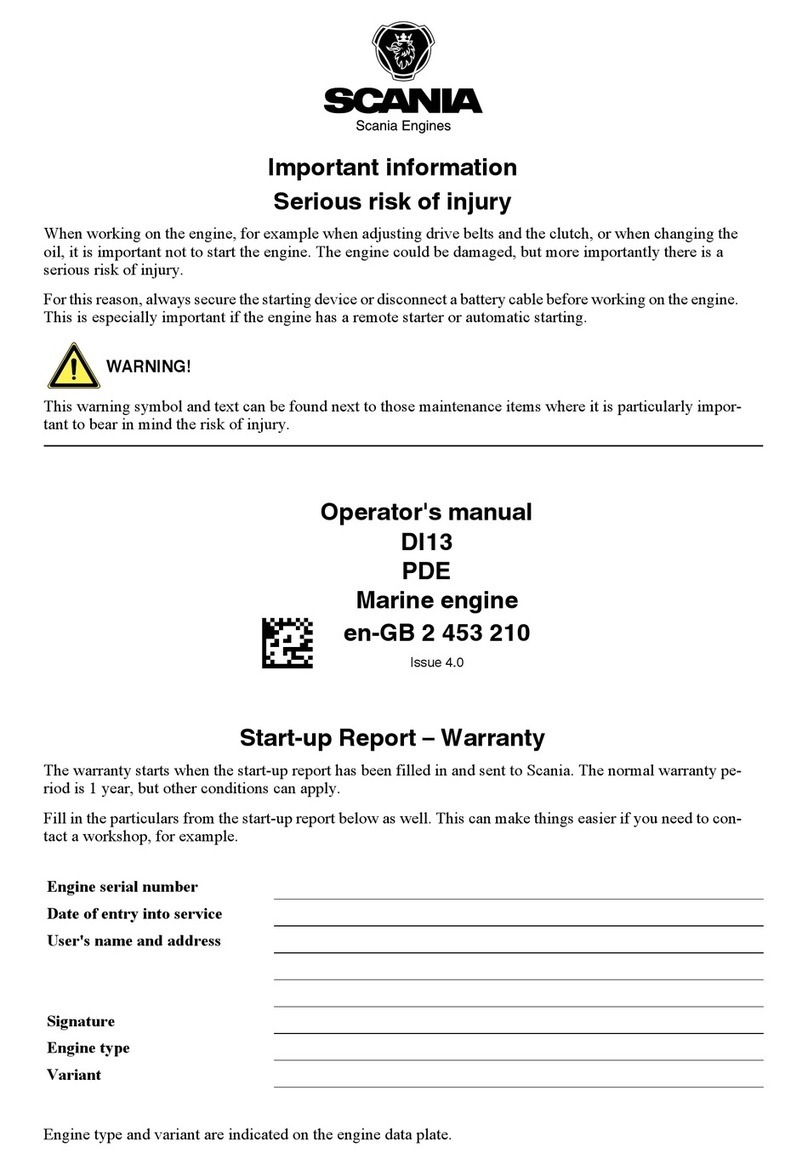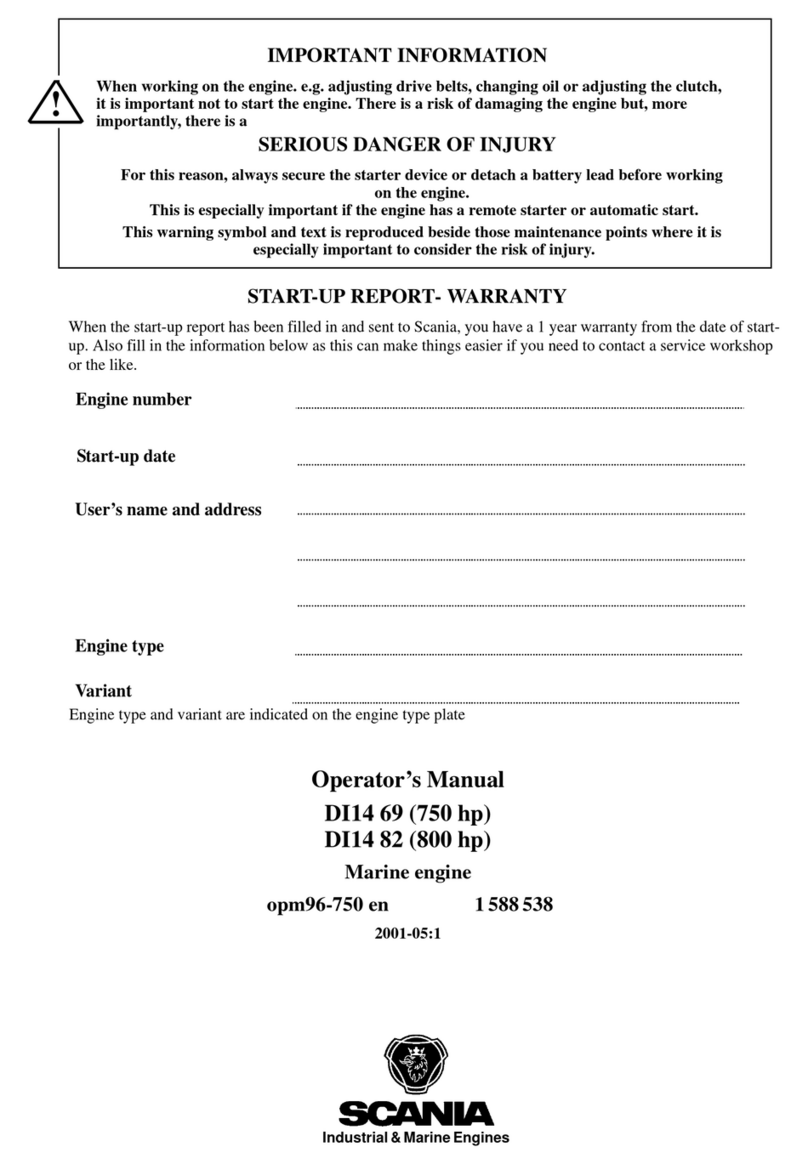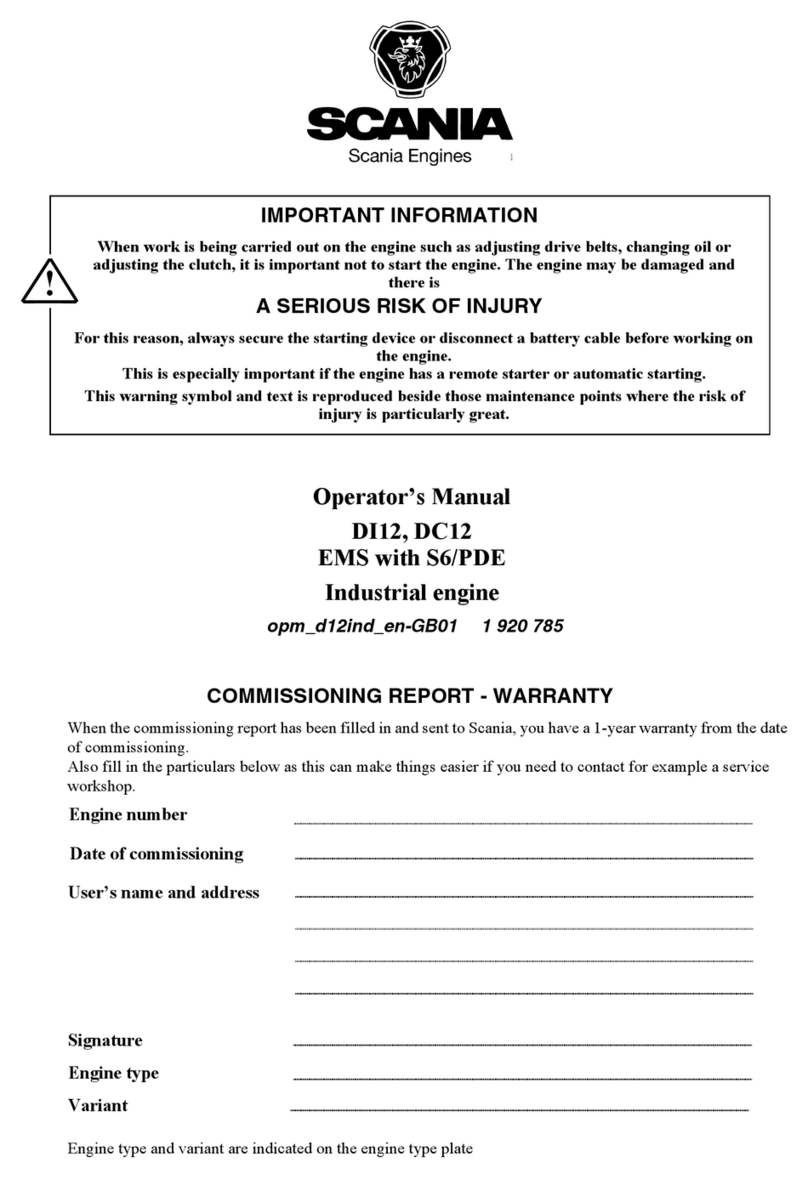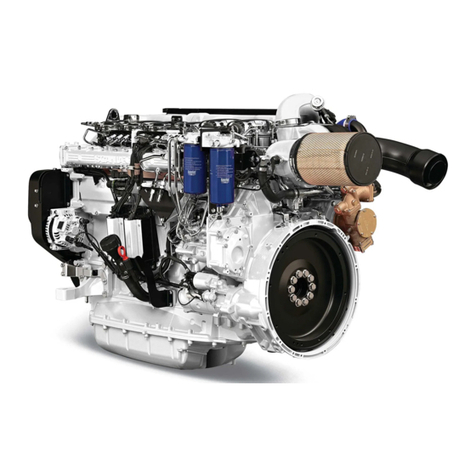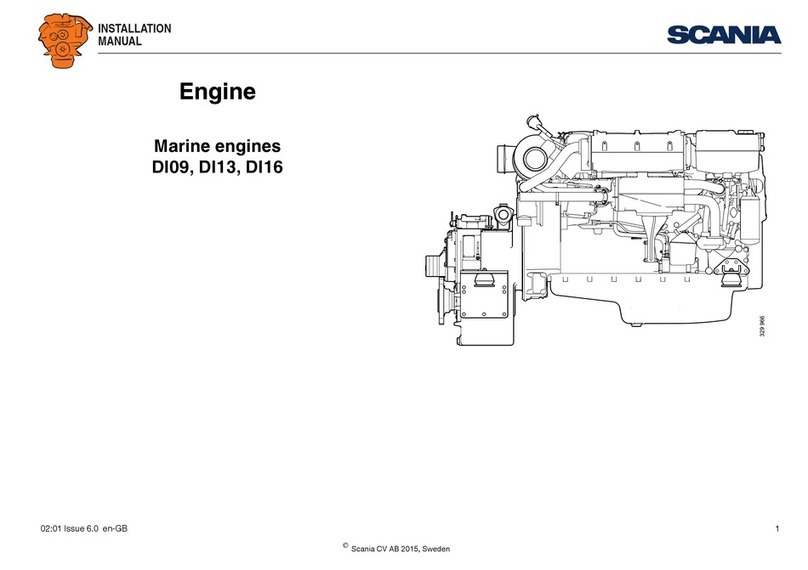
OPM 260 en-GB 2
©
Scania CV AB 2021, Sweden
Start of warranty . . . . . . . . . . . . . . . . . . . . . . . . 3
Introduction . . . . . . . . . . . . . . . . . . . . . . . . . . . . 4
Certification . . . . . . . . . . . . . . . . . . . . . . . . . . . . 4
Power classes . . . . . . . . . . . . . . . . . . . . . . . . . . . 6
Environment and safety . . . . . . . . . . . . . . . . . . 7
Environmental liability . . . . . . . . . . . . . . . . . .
Safety . . . . . . . . . . . . . . . . . . . . . . . . . . . . . . .
Warnings and advisories . . . . . . . . . . . . . . . . . 8
Scania Engines engine warranty for marine en-
gines . . . . . . . . . . . . . . . . . . . . . . . . . . . . . . . . . 13
Emission control systems warranty. . . . . . . . 13
Emission control system warranty statement 13
Engine data plate . . . . . . . . . . . . . . . . . . . . . . . 16
Component identification . . . . . . . . . . . . . . . . 17
Starting and running . . . . . . . . . . . . . . . . . . . . 1
Checks before first start . . . . . . . . . . . . . . . . 18
Checks before running . . . . . . . . . . . . . . . . . 18
Starting the engine . . . . . . . . . . . . . . . . . . . . 18
Running. . . . . . . . . . . . . . . . . . . . . . . . . . . . . 19
Engine shutdown. . . . . . . . . . . . . . . . . . . . . . 22
Checks after running . . . . . . . . . . . . . . . . . . . 22
Maintenance . . . . . . . . . . . . . . . . . . . . . . . . . . . 23
Cleaning the engine. . . . . . . . . . . . . . . . . . . . 24
Maintenance interval. . . . . . . . . . . . . . . . . . . 25
Lubrication system . . . . . . . . . . . . . . . . . . . . . 27
Oil grade . . . . . . . . . . . . . . . . . . . . . . . . . . . . 2
Oil analysis . . . . . . . . . . . . . . . . . . . . . . . . . . 29
Checking the oil level . . . . . . . . . . . . . . . . . . 30
Maximum angles of inclination during operation
30
Changing the oil . . . . . . . . . . . . . . . . . . . . . . 31
Cleaning the centrifugal oil cleaner . . . . . . . 32
Operational testing of the centrifugal oil cleaner
36
Renewing the oil filter. . . . . . . . . . . . . . . . . . 3
Air cleaner . . . . . . . . . . . . . . . . . . . . . . . . . . . . 3
Reading the vacuum indicator. . . . . . . . . . . . 38
Renewing the air cleaner filter element and safe-
ty cartridge . . . . . . . . . . . . . . . . . . . . . . . . . . 39
Renewing an air filter with a non-renewable ele-
ment. . . . . . . . . . . . . . . . . . . . . . . . . . . . . . . . 39
Cooling system . . . . . . . . . . . . . . . . . . . . . . . . . 40
Coolant . . . . . . . . . . . . . . . . . . . . . . . . . . . . . 40
Checking the coolant level . . . . . . . . . . . . . . 45
Checking the coolant's antifreeze and corrosion
protection . . . . . . . . . . . . . . . . . . . . . . . . . . . 46
Checking the sacrificial anodes. . . . . . . . . . . 4
Checking the sea water pump impeller . . . . . 48
Changing the coolant and cleaning the cooling
system . . . . . . . . . . . . . . . . . . . . . . . . . . . . . . 49
Fuel system . . . . . . . . . . . . . . . . . . . . . . . . . . . . 61
Cleanliness requirements . . . . . . . . . . . . . . . 61
Checking the fuel level . . . . . . . . . . . . . . . . . 61
Renewing the fuel filter . . . . . . . . . . . . . . . . .62
Draining and renewing an engine-mounted water
separating prefilter . . . . . . . . . . . . . . . . . . . . .63
Draining and renewing the single water separat-
ing prefilter (option). . . . . . . . . . . . . . . . . . . .64
Draining the reversible water separating prefilter
(option). . . . . . . . . . . . . . . . . . . . . . . . . . . . . .65
Renewing the reversible water separating prefil-
ter (option) . . . . . . . . . . . . . . . . . . . . . . . . . . .6
Bleeding the fuel system . . . . . . . . . . . . . . . .69
Miscellaneous . . . . . . . . . . . . . . . . . . . . . . . . . .72
Checking the drive belt . . . . . . . . . . . . . . . . . 2
Checking for leakage . . . . . . . . . . . . . . . . . . . 3
Checking and adjusting the valve clearance . 4
Quality requirements for fuel . . . . . . . . . . . . .77
Diesel . . . . . . . . . . . . . . . . . . . . . . . . . . . . . . .
Biodiesel (FAME) . . . . . . . . . . . . . . . . . . . . . 8
HVO . . . . . . . . . . . . . . . . . . . . . . . . . . . . . . . . 9
GTL . . . . . . . . . . . . . . . . . . . . . . . . . . . . . . . . 9
Preparing the engine for storage . . . . . . . . . . . 0
Preservative products . . . . . . . . . . . . . . . . . . .80
Preparations for storage . . . . . . . . . . . . . . . . .82
Technical data . . . . . . . . . . . . . . . . . . . . . . . . . . 4
General data . . . . . . . . . . . . . . . . . . . . . . . . . .84
Lubrication system . . . . . . . . . . . . . . . . . . . . .84
Intake system . . . . . . . . . . . . . . . . . . . . . . . . .85
Cooling system. . . . . . . . . . . . . . . . . . . . . . . .85
Fuel system. . . . . . . . . . . . . . . . . . . . . . . . . . .85
Electrical system . . . . . . . . . . . . . . . . . . . . . .85
Material content . . . . . . . . . . . . . . . . . . . . . . .86
Scania Assistance . . . . . . . . . . . . . . . . . . . . . . . 7
General tightening torques for screw joints . .
Hexagon screws, hexagon socket screws, Torx
screws, hexagon nuts . . . . . . . . . . . . . . . . . . .88
Flange screws with hexagonal head and hexago-
nal flange nuts . . . . . . . . . . . . . . . . . . . . . . . .88
Hose clamps . . . . . . . . . . . . . . . . . . . . . . . . . .89




